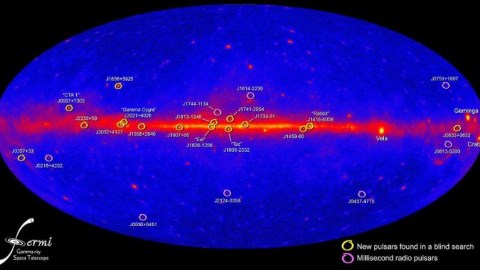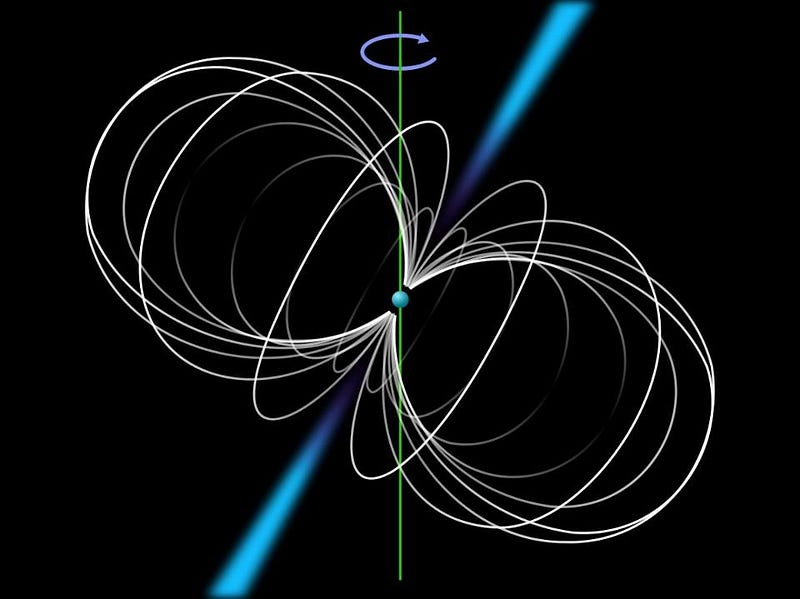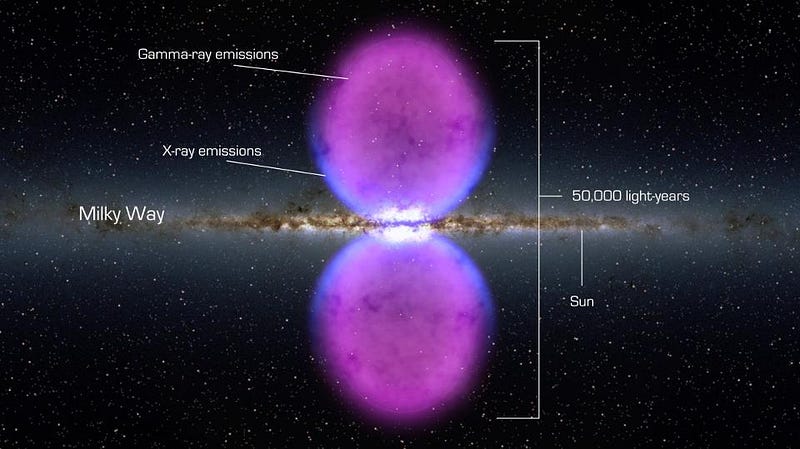No, mysterious signals from space are not dark matter

If you have a choice between “known astrophysical objects” and “new physics,” bet on the known.
“Two recent studies by teams in the U.S. and the Netherlands have shown that the gamma-ray excess at the galactic center is speckled, not smooth as we would expect for a dark matter signal. Those results suggest the speckles may be due to point sources that we can’t see as individual sources…” –Eric Charles
Space is a strange place, and the variety of objects and phenomena in the Universe is always fertile ground for scientific investigation. Sometimes we find particles or energy signatures where we don’t expect them; sometimes the details differ from what our theories or models predict; sometimes a light signal appears where there’s no astrophysical source to account for it. In all of these cases, it’s a fantastic opportunity to learn something new about our Universe.
But while our imaginations — and this includes the imaginations of many scientists — might immediately run to novel phenomena like exotic particles, dark matter, or new physics, that should be a last resort. Instead, a new twist on how the existing laws and rules of physics apply to a novel scenario almost always holds the actual explanation. In particular, high-energy photons originating from the galactic center were one such mystery that many hoped dark matter would be the solution to. But it looks like “normal astrophysics” is the answer, after all.

NASA’s Fermi satellite measures gamma rays: the highest-energy photons that are naturally produced in our Universe. There are some known astrophysical sources for them, mostly in the form of pulsars. Pulsars are ultra-collapsed cores from supermassive stars that have exploded. The cores themselves are like one giant atomic nucleus perhaps a few kilometers across, containing more than the mass of the Sun in that tiny volume. The interior of a pulsar in 90% made up of neutrons, with charged particles like protons and electrons existing in the outer layers. They spin incredibly rapidly — the fastest known pulsar rotates 766 times per second — creating intense magnetic fields that are billions of times as strong as anything ever made on Earth.

Not only can pulsars accelerate charged particles to incredibly high energies, but they can spontaneously cause the creation of electron/positron pairs. Thanks to Einstein’s E = mc2, we know it’s possible to create pairs of matter and antimatter out of pure energy, and pulsars are among the astrophysical sources in the Universe powerful enough to do this naturally. When a positron travels through the Universe, it’s only a matter of time before it runs into a particle of normal matter, with an electron being the most common encounter. When positrons and electrons interact, they both annihilate, producing two photons of a very particular energy: 511 keV apiece.

These gamma ray photons are what Fermi has seen. What Fermi discovered, years ago, was that there was an excess of these gamma rays over and above what was predicted, coming from the galactic center. Many hopeful astrophysicists noted that there are also dark matter halos predicted to center on galaxies, and that the density of dark matter will be greatest in the galactic center. If dark matter has just the right particle properties, it could annihilate with itself, producing these same electron/positron pairs and the resulting gamma ray excess we see.

Given these two possibilities — either there’s some “mundane” high-energy astrophysical phenomenon at play or there’s dark matter annihilating with itself — which one would you investigate first? If you’re thinking like a scientist, your first instinct should be to look to the known astrophysical possibilities as the default explanation. It’s only if that explanation fails that we should even begin seriously considering the more “exotic” scenario of dark matter. We know pulsars and black holes exist; we know they create matter/antimatter pairs; we know they can produce an excess of 511 keV photons. For dark matter, we only have indirect evidence (through its gravitational effects) that it exists; we don’t know what it creates or how (or if) it interacts otherwise.

Pulsars represent a full 70% of all known gamma ray sources in the Milky Way. According to the latest results of the Fermi-LAT collaboration, a survey of a spatial region encompassing 1,600 square degrees and focused on the galactic center revealed approximately 400 point sources of gamma ray emission. They’ve been able to derive that if the galactic disk contains 270% as many pulsars as the galactic bulge has, then pulsars can explain this gamma ray excess from the galactic center entirely. A total of about 1,000 pulsar sources would explain the entirety of the gamma ray signal. The detected sources also have a different spectral profile than dark matter models indicate, disfavoring the dark matter explanation even further.

But the strongest indicator that this is pulsars and not dark matter comes when we begin to look at other galaxies. While all galaxies ought to have dark matter halos, only galaxies that formed stars relatively recently, within the past one billion years or so, should have pulsars in them. That would mean, if pulsars were correct, galaxies like Andromeda and the Milky Way should show gamma ray excesses from their centers, but not most dwarf galaxies in our neighborhood. According to Seth Digel, member of the Fermi-LAT team:
If the signal were due to dark matter, we would expect to see it also at the centers of other galaxies. The signal should be particularly clear in dwarf galaxies orbiting the Milky Way. These galaxies have very few stars, typically don’t have pulsars and are held together because they have a lot of dark matter. However, we don’t see any significant gamma-ray emissions from them.
When you see something unexpected, there’s always a chance it’s something novel and exciting, like dark matter. But more often than not, if there’s a chance that the physics and astrophysical objects we already know of can account for it, that’s where the answer lies. Our minds may instinctively be drawn to the most fantastic and exciting possibilities, but that’s our own bias. In the end, as it did in this case, the key to doing good science is discriminating between the signatures of different possible mechanisms. In this case, it’s pulsars, not dark matter, that explain the incredible energy signal coming from our galaxy’s center.
Ethan Siegel is the author of Beyond the Galaxy and Treknology. You can pre-order his third book, currently in development: the Encyclopaedia Cosmologica.





